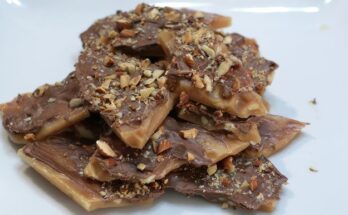Baked Rice Pudding Recipe: Craving a nostalgic dessert that warms both your heart and your belly? Enter baked rice pudding—a timeless comfort dish that’s creamy, subtly sweet, and oh-so-satisfying. This old-fashioned dessert, often found on grandma’s dinner table, is made with simple ingredients like milk, sugar, and rice, baked slowly to create a golden, caramelized top and a luscious, custard-like base.
What sets baked rice pudding apart from its stovetop cousin is its texture. While stovetop pudding is silky smooth, baked rice pudding gives you a chewy, almost caramelized edge and a firmer, set custard body that’s deeply indulgent. Whether served warm on a chilly evening or cold on a summer day, it’s a versatile treat that never fails to please.
Ingredients You’ll Need
Let’s talk about what goes into this irresistible dessert. The beauty lies in its simplicity—most of these ingredients are probably in your kitchen right now.
Rice
The foundation of this dish. Short-grain white rice is ideal because it becomes soft and creamy when cooked. Arborio rice, often used in risotto, works beautifully too, offering a rich, creamy consistency.
- 1 cup short-grain white rice (or Arborio)
- Avoid long-grain rice, which tends to stay firm and separate.
Milk
Whole milk is your best bet—it brings the creamy texture rice pudding is known for. If you want a richer dessert, mix in some cream or evaporated milk.
- 4 cups whole milk
- Optional: 1 cup heavy cream for extra richness
Sweeteners and Flavoring
Classic rice pudding relies on sugar and a hint of vanilla. You can play with spices like cinnamon or nutmeg to give it that cozy, aromatic flavor.
- ¾ cup granulated sugar
- 1 tsp vanilla extract
- Optional: ½ tsp ground cinnamon or nutmeg
Optional Add-ins
Want to make it more exciting? Toss in some raisins, chopped nuts, or even a splash of rum.
- ½ cup raisins (optional)
- ¼ cup chopped almonds or walnuts
- Zest of one lemon or orange for brightness
Kitchen Tools Required
Before we dive into the cooking process, gather your tools:
- Medium saucepan (for precooking rice)
- Mixing bowl
- Whisk
- 9×13-inch baking dish
- Measuring cups and spoons
- Aluminum foil (for covering)
- Oven mitts
Having these ready makes the process smoother and way more enjoyable.
Preparing the Ingredients
Preparation is half the battle. Start by rinsing the rice to remove excess starch. This helps prevent the pudding from getting too sticky. Soak raisins (if using) in warm water or a splash of rum for 10 minutes to plump them up.
Crack your eggs (if your recipe includes them), whisk them gently, and set aside. Measure out your sugar, vanilla, and any spices you plan to use. Prepping everything in advance saves time and ensures you don’t forget anything mid-recipe.
Step-by-Step Cooking Instructions
Let’s get baking! This process is broken into simple, easy-to-follow steps that’ll have your kitchen smelling heavenly in no time.
Step 1: Preheat Your Oven
Start by preheating your oven to 325°F (165°C). This low, slow bake ensures the custard sets without curdling and that perfect golden top forms evenly.
Step 2: Cook the Rice
In a saucepan, combine the rice with two cups of water. Bring it to a gentle boil, then reduce the heat and simmer for about 10–15 minutes, or until most of the water is absorbed but the rice is still slightly firm. It will continue to cook in the oven, so don’t overdo it here.
Drain any excess water if needed and let the rice cool slightly.
Step 3: Mix Milk, Sugar, and Eggs
In a large mixing bowl, whisk together the milk, sugar, eggs, vanilla extract, and any spices you’re using. Whisk until the sugar dissolves and everything is well blended.
- If using cream, mix it in now for extra richness.
- For a smoother custard, strain the mixture to remove any egg clumps.
Step 4: Combine All Ingredients
Fold the cooked rice into the milk mixture. Stir in your raisins, nuts, or citrus zest at this stage if desired. Pour the entire mixture into your greased baking dish.
Make sure the rice is evenly distributed so every bite has that perfect balance of soft custard and chewy grains.
Step 5: Bake to Perfection
Cover the dish with foil and place it in the preheated oven. Bake for 45 minutes, then remove the foil and bake for another 15–20 minutes uncovered. You’ll know it’s ready when the top is golden brown, and a knife inserted in the center comes out mostly clean.
Let it cool for at least 15 minutes before serving. This allows the custard to set fully.
Tips for the Best Rice Pudding
Want your baked rice pudding to come out chef’s kiss perfect every single time? Here are some insider tips that make a huge difference:
- Use warm milk – Adding warm (not boiling) milk to the mixture helps blend everything more evenly and prevents the custard from curdling.
- Don’t skip the pre-cook – Pre-cooking the rice ensures it’s tender without being mushy by the end of baking. Skipping this step may leave you with crunchy or undercooked grains.
- Grease the baking dish – This helps prevent sticking and makes cleanup much easier.
- Use fresh eggs – They help bind the custard and add richness to the dessert. Always whisk them well to avoid scrambling.
- Let it rest – After baking, allow the pudding to rest and cool slightly. This sets the texture and makes slicing or scooping more satisfying.
A little attention to detail goes a long way. Think of it like planting a garden—you need to nurture it just right to see those delicious results bloom.
Common Mistakes to Avoid
Even the simplest recipes can go wrong if you’re not careful. Here are a few pitfalls to watch out for when making baked rice pudding:
- Overcooking the rice beforehand – If you fully cook the rice on the stove, it may turn mushy during baking. You want it partially cooked so it finishes in the oven.
- Baking at too high a temperature – A high oven temp can curdle the custard and make the pudding rubbery. Stick to 325°F for a silky texture.
- Skipping the foil cover – Covering the pudding for the first part of baking prevents the top from drying out before the custard sets.
- Not stirring before baking – Make sure to stir the mixture well after adding rice and other ingredients so everything is evenly distributed.
- Using low-fat milk – You can use it, but it won’t be as creamy. Whole milk or a milk-cream mix is the way to go.
Think of these as the potholes on the road to dessert heaven—steer clear and you’ll get there just fine.
Serving Suggestions
Rice pudding is incredibly versatile when it comes to serving. You can dress it up or keep it plain—it’ll still taste amazing. Here are a few ideas to take your presentation to the next level:
- Classic & warm – Serve straight from the oven with a dusting of cinnamon.
- Chilled & fancy – Let it cool completely and top with a dollop of whipped cream and a sprig of mint.
- With fruit – Add a spoonful of fruit compote, fresh berries, or even mango slices on top.
- Drizzle it up – Caramel sauce, chocolate syrup, or even a little maple syrup can make it even more indulgent.
- Add crunch – Top with toasted almonds, crushed pistachios, or even granola for a delightful texture contrast.
Perfect for holidays, potlucks, or just a weeknight craving—this dish adapts to any occasion like a charm.
Storing and Reheating Leftovers
Have leftovers? Great! Baked rice pudding keeps surprisingly well, and you can enjoy it for days. Here’s how to store and reheat it properly:
Storage:
- Transfer to an airtight container or cover the baking dish tightly with plastic wrap or foil.
- Store in the refrigerator for up to 5 days.
- Do not leave it out at room temperature for more than 2 hours.
Reheating:
- Microwave individual portions for about 1–2 minutes, stirring halfway through for even heating.
- To reheat larger portions, cover the dish with foil and warm in a 300°F oven for 15–20 minutes.
- Add a splash of milk before reheating to keep it moist and creamy.
Pro tip: It actually tastes better the next day—like most comfort foods that get a chance to sit and soak in all their flavors.
Variations to Try
Once you’ve mastered the classic, why not give it a little twist? Here are some exciting variations to spice things up:
- Coconut Rice Pudding: Replace some of the milk with coconut milk and top with toasted coconut flakes.
- Chocolate Rice Pudding: Add cocoa powder and chocolate chips to the mixture before baking for a rich, fudgy treat.
- Lemon or Orange Zest: Add a citrusy twist for a brighter, fresher flavor.
- Chai-Spiced: Mix in cardamom, cinnamon, cloves, and ginger for a warming, spiced version.
- Bourbon Vanilla: Add a splash of bourbon along with the vanilla for an adult-friendly take.
Don’t be afraid to experiment. Think of baked rice pudding as your canvas—flavor it your way.
Nutritional Breakdown
Rice pudding is indulgent, no doubt—but if you’re mindful about what you eat, it’s good to know what’s going into your bowl. Here’s an approximate nutritional breakdown per serving (based on a standard recipe with whole milk, sugar, and raisins, divided into 8 servings):
| Nutrient | Amount per Serving |
|---|---|
| Calories | 280–320 kcal |
| Total Fat | 8–10g |
| Saturated Fat | 4–5g |
| Carbohydrates | 50–55g |
| Sugars | 25–30g |
| Protein | 6–8g |
| Fiber | 1g |
| Sodium | 60–100mg |
| Calcium | 15–20% DV |
Note: These values can vary depending on the type of milk, sweetener, and add-ins used. Want a healthier version? Try reducing sugar, using low-fat milk, or replacing raisins with chopped dates or apples for natural sweetness.
While rice pudding isn’t exactly diet food, it does offer some nutritional benefits—like calcium from milk and some protein. As with most desserts, moderation is key.
FAQs about Baked Rice Pudding Recipe
1. Can I make rice pudding with leftover cooked rice?
Yes! Leftover rice is actually perfect for rice pudding. Just reduce the pre-cooking time and mix it directly with the milk and other ingredients before baking.
2. Is baked rice pudding gluten-free?
It can be! As long as you use gluten-free rice and avoid any flavorings or thickeners with gluten, it’s naturally gluten-free.
3. Can I freeze baked rice pudding?
Absolutely. Let it cool completely, store in airtight containers, and freeze for up to 3 months. Thaw in the fridge overnight and reheat before serving.
4. How can I prevent rice pudding from drying out?
Cover it with foil while baking and add a splash of milk before reheating to keep it creamy.
5. What’s the best rice for pudding?
Short-grain white rice or Arborio rice works best. They soak up liquid and become wonderfully creamy during baking.
Conclusion
Baked rice pudding is more than just a dessert—it’s comfort in a casserole dish, nostalgia in a bite, and a testament to the magic of simple ingredients. Whether you’re recreating a family favorite or trying it for the first time, the recipe’s charm lies in its versatility and ease.
From the creamy custard base to the golden-baked top, every spoonful tells a story. You can stick to the traditional version or get creative with fun flavors and toppings. It’s the kind of dish that fits in at a holiday dinner just as easily as it does on a lazy Sunday afternoon.
So grab your ingredients, heat up that oven, and let the magic happen. Your kitchen’s about to smell like a warm hug—and trust me, your taste buds will thank you.



